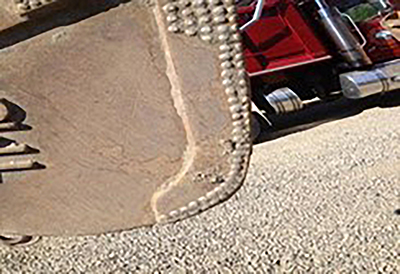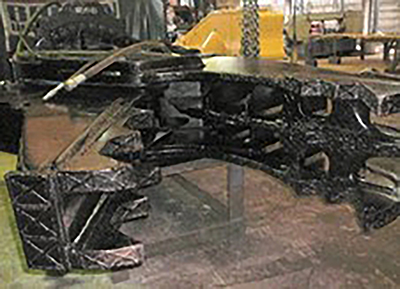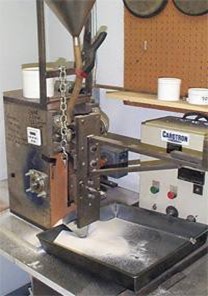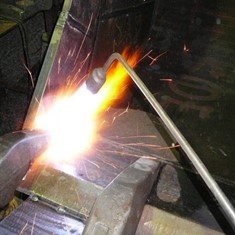Hardfacing Is A Cost-Effective Tool That Will Minimize Wear And Increase Service Life.
Edited by Mark S. Kuhar
This is the second article in a two-part series.
All industries have parts and equipment that are exposed to some type of destructive wear. Hardfacing is a cost-effective tool that will minimize wear and increase service life. At first glance, hardfacing can be confusing and troublesome. In reality, it is not. Understanding some of the basics about hardfacing can go a long way toward instilling confidence in your hardfacing product selection.
Postle Industries, a manufacturer of hardfacing products, has answers to frequently asked questions that may help you select hardfacing products that are most appropriate for your application.


What is meant by hardfacing pattern?
When working in rocky earth, ore or slag, the goal is to not trap the soil on the surface, but to protect the surface underneath from abrasion caused by the movement of the rocks over the surface. This can be done by applying a series of ridges or weld beads parallel to the flow of material, like rails. This will prevent the rocky soil from coming in contact with the surface.
When working in dirt or sand, apply hardface weld beads spaced from ¼-in. (6.4 mm) to 1-1/2-in. (38 mm) apart and perpendicular or against the flow of an abrasive material. Forcing the material to compact between the weld beads works well for finely grained sands and soils.
Apply a dot pattern to areas that do not see heavy abrasion, but are subjected to wear, or when weld areas are hard to reach. A dot pattern is also used on thin base metals, when distortion and warpage may be an issue from overheating of the base metal.
When working in soil with some clay content, the goal is to use a hardfacing pattern that traps the soil on the surface, forming a layer of trapped soil that will protect the surface underneath. This is best done with a crosshatch or waffle pattern, which also works well with a combination of fine and coarse soil.
Can hardness values be used to predict abrasion resistance?
No, this isn’t a good idea. A martensitic alloy and a chromium carbide alloy can have the same hardness, let us say 58 HRC, and perform vastly different under the same abrasive conditions.
A chromium carbide alloy will provide better abrasion resistance than a martensitic alloy. The metallurgical microstructure is a better measuring stick, but that isn’t always available.
The only time hardness can be used to predict wear is when the alloys being evaluated are within the same family. For example, in the martensitic family, a 55 HRC alloy will have better abrasion resistance than a 35 HRC alloy.
This may or may not be the case in either the austenitic or metal carbide families. Again, you must consider the microstructure. You should consult with the manufacturer for recommendations.

If hardness is unreliable, then how is wear measured?
It depends on the type of wear involved, but in the case of abrasive wear – by far the most predominant wear mechanism – the ASTM Intl. G65 Dry Sand Rubber Wheel Test is used extensively. Essentially, this is a test in which the sample is weighed before and after the test, and the result is usually expressed in grams of weight loss or volume loss.
A sample is held against a spinning rubber wheel with a known force for several set number of revolutions. A specific type of sand, which is sized carefully, is trickled down between the sample and rubber wheel. This simulates pure abrasion, and the numbers are used as guidelines in material selection.
What type of gas is used in GMAW hardfacing?
Low penetration and dilution are the major objectives in hardfacing, so pure argon and mixtures of argon with oxygen or carbon dioxide generally will produce the desired result. You also can use pure carbon dioxide, but you may get more spatter than you would with an argon mixture.
What is a ball, or globular, transfer, and why is it important?
Welding wires produce either a spray transfer or a globular (ball) transfer of molten metal across the welding arc. Spray transfer is a dispersion of fine molten metal drops and can be characterized as a smooth-sounding transfer. These wires are desirable in joining applications in which you require good penetration.
Ball transfer wires disperse larger molten metal drops, or balls. This type of transfer promotes low penetration and dilution, suitable for hardfacing. It has a noisier arc that produces an audible crackling sound and generally has a higher spatter level than spray transfer wires. Welding parameters such as electrical stick-out, gas (if any), amperage, and voltage can affect the size of the ball and its transfer. Gasless or open arc wires all have a globular or ball transfer.

Must parts be preheated before hardfacing?
Heat Affected Zone cracking is always a concern when welding low alloy and high carbon steels, and highly stressed parts or parts with complex shapes. As a rule, all parts should be welded at least at room temperature. You should select higher preheat and interpass temperatures based on the base metal chemistry and hardfacing product you are using. High carbon steels will require preheating. For example, steel made from 4130 generally requires a preheat of 400ºF(200ºC). Steel for rails is typically high carbon and requires a minimum preheat of 600ºF to 700ºF (315ºC to 370ºC).
Manganese steel and some stainless steels require NO preheating, and welding temperatures should be kept as low as possible. In fact, steps should be taken to keep the manganese base metal below 500ºF (260ºC).
You should consult the manufacturer for the best combination to prevent cracking and spalling.
When is a cobalt or nickel hardfacing alloy used?
Cobalt alloys contain many types of carbides and are good for severe abrasion at high temperatures. They also have good corrosion resistance for some applications.
Deposit hardness ranges from 25 HRC to 55 HRC. Work-hardening alloys also are available.
Nickel-base alloys can contain chromium borides that resist abrasion. They can be good particularly in corrosive atmospheres and high temperatures when abrasion is a problem.
Why are some hardfacing products limited to two or three layers?
Chromium carbide, such as Postalloy 2834-MCO wire or complex carbides, such as 2836-MCO wire, are generally limited in the number of layers that can be applied. Electrodes include Postalloy 214, 215HD or 218HD.
The brittle nature of the metal carbides leads to check-cracking, and as multiple layers are applied, stress continues to build, concentrating at the root of the check cracks, until separation or spalling occurs between the parent metal or buffer and the hardfacing deposit.
Unless otherwise specified by the manufacturer, and with the correct procedures, martensitic hardfacing alloys, such as Postalloy 21 electrodes or 2898-MCG wire, can be applied in multiple layers. Austenitic manganese hardfacing products, such as Postalloy 2850-FCO, can be applied in unlimited layers unless the manufacturer specifies otherwise.
Be sure to follow the manufactures recommendation pertaining to number of layers. If more layers are required a buffer or build-up alloy should be used.
What is meant by a build-up or buffer alloy?
These alloys are similar to the parent metal alloy in hardness and strength, with two main functions. Products that fit this category include Postalloy 27 electrode and 2891-MCG wire.
- They are applied to severely worn parts to bring them back to dimension where machining must be used after welding. Hardness ranges from 30 HRC to 45 HRC.
- They are applied as a buffer for subsequent layers of a more wear-resistant hardfacing deposit. If the hardfacing alloy produces check cracks, such as a chromium carbide alloy, then it’s wise to use a tough manganese product as the buffer to blunt and stop the cracks from penetrating into the base metal.
A mild steel electrode, or wire such as 7018 or E70S6, should never be used for build-up or as a buffer layer. While mild steel welding products are great for joining and fabricating, they do not have the strength and hardness to support hardfacing. A soft mild steel buffer layer will collapse under the hardface layer, causing the hardface layer to spall off and fail.
Can cast iron be hardfaced?
Yes, but you should consider preheat and interpass temperatures. Nickel and nickel-iron products usually are suitable for rebuilding cast iron. These products are not affected by the carbon content of the parent metal and remain ductile. Multiple layers are possible. If further wear protection is required, metal carbide products can work well on top of the nickel or nickel-iron build-up.
Conclusion:
The frequently asked questions in both part one and part two of this series only begin to address hardfacing. Hardfacing product manufacturers and specialists can contribute to a greater in-depth understanding of hardfacing and help assist you in product and process selection for your application.
Information courtesy of Postle Industries Inc., 216-265-9000, www.postle.com.
